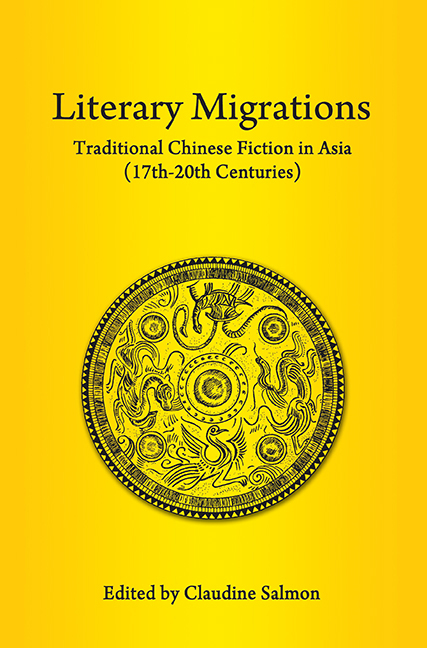Book contents
- Frontmatter
- Contents
- FOREWORD
- Dr Salmon as I Know her
- Preface to Reprint Edition
- Acknowledgements
- INTRODUCTION
- PART I KOREA AND JAPAN
- 1 The Influence of Chinese Stories and Novels on Korean Fiction
- 2 The Plots of Chinese Fiction in Korean Vernacular Novels
- 3 Chinese Colloquial Novels in Japan — Mainly during the Edo Period (1603–1867)
- PART II MAINLAND NORTHEAST ASIA
- PART III MAINLAND SOUTHEAST ASIA
- PART IV INSULAR SOUTHEAST ASIA
- Bibliography
- Author, story-teller and translator index
- Title index
- List of Plates
- Contributors
- Plate section
3 - Chinese Colloquial Novels in Japan — Mainly during the Edo Period (1603–1867)
from PART I - KOREA AND JAPAN
Published online by Cambridge University Press: 21 October 2015
- Frontmatter
- Contents
- FOREWORD
- Dr Salmon as I Know her
- Preface to Reprint Edition
- Acknowledgements
- INTRODUCTION
- PART I KOREA AND JAPAN
- 1 The Influence of Chinese Stories and Novels on Korean Fiction
- 2 The Plots of Chinese Fiction in Korean Vernacular Novels
- 3 Chinese Colloquial Novels in Japan — Mainly during the Edo Period (1603–1867)
- PART II MAINLAND NORTHEAST ASIA
- PART III MAINLAND SOUTHEAST ASIA
- PART IV INSULAR SOUTHEAST ASIA
- Bibliography
- Author, story-teller and translator index
- Title index
- List of Plates
- Contributors
- Plate section
Summary
A large number of Chinese colloquial novels were imported into Japan during the Edo period (1603–1867)and they had much influence upon the literature of the age, because before the Edo period the only foreign literature known to Japanese was Chinese literature (with one exception: a missionary translated Aesop's Fables into Japanese in the latter half of the sixteenth century).
Of course, during the Meiji period (1868–1912)and after, Chinese colloquial novels were still introduced and translated, in quantity and quality not inferior to those of the Edo period. But by that time European literature had become more influential than Chinese literature in Japan, so we will deal here with the colloquial novel during the Edo period, when its influence was especially important.
1. Conditions under which Books Were Imported and the Problem of Language Barrier
Chinese colloquial novels began to enter Japan in the middle of the eighteenth century although their heyday in China was the end of the sixteenth and beginning of the seventeenth centuries. In the Edo period, the Japanese practised a policy of national isolation. Trade with Spain and Portugal was banned in order to prohibit Christianity. Only the Chinese and the Dutch, who were not engaged in missionary work, were permitted to trade, and then only in the port of Nagasaki.
The Tokugawa government, however, tolerated the importation of books, except for books dealing with Christianity. So the people eagerly sought for books from China and Holland which were their only links with the outside world. While most books from Holland dealt with technology, those from China covered a wide range, including literature and even colloquial novels which were thought little of in China, but had great influence on Japanese literature. We may get an idea of the various kinds of books imported during the Edo period by checking the catalogues of imported books. We can also make a survey of the Chinese novels imported during the same period by using the Shôsetsu jii, a dictionary of colloquial Chinese published in 1784.
The Japanese people formed their culture under Chinese influence, through books and artifacts, not through Chinese people.
- Type
- Chapter
- Information
- Literary MigrationsTraditional Chinese Fiction in Asia (17th–20th Centuries), pp. 73 - 90Publisher: ISEAS–Yusof Ishak InstitutePrint publication year: 2013

